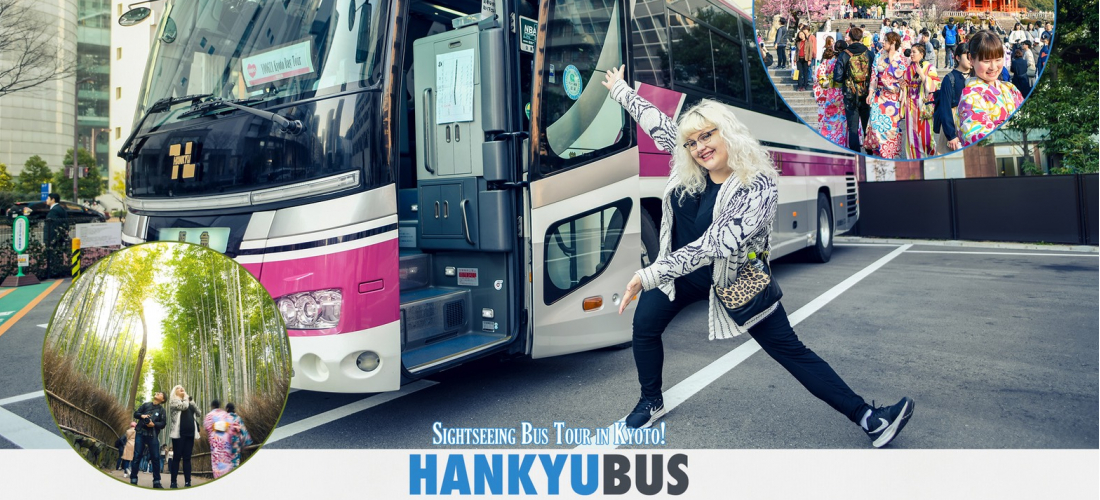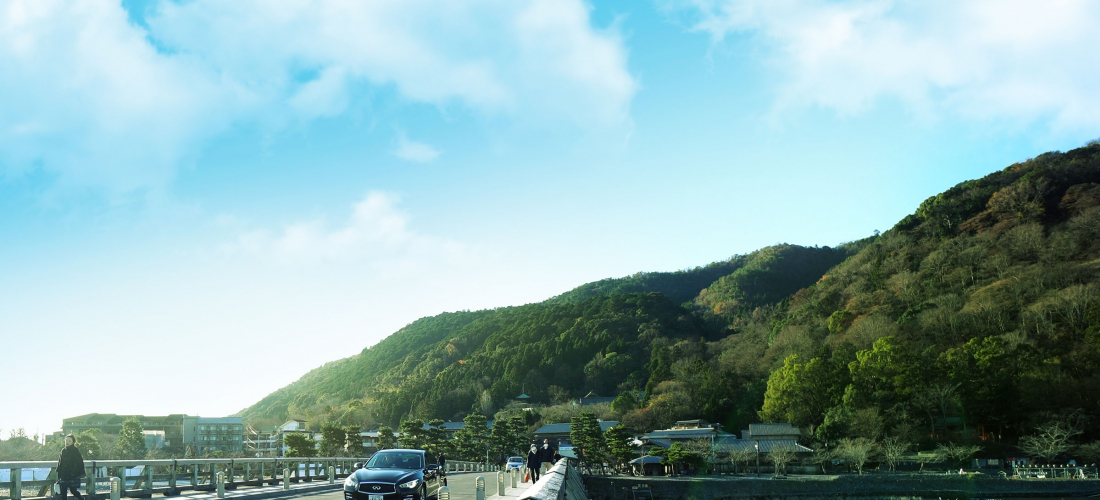
Going to Top Kyoto Sightseeing Spots with 🚌WOW BUS!🚌
The Most Popular Place to Visit in Japan 2018, Kyoto
and it's easy to see why…
it's the formal Imperial capital of Japan (its name even means "capital city"),
famous for green tea,
geisha/maiko/oiran, gardens, old tea houses,
small "old Japan" style building,
making it the heart of the remaining traditional side of Japan.
Despite all of those great factors,
it isn't as easy to get around and visit places in Kyoto as it is in say Tokyo.
Which makes things even more stressful when traveling.
That's why we wanted to recommend a sightseeing bus service we took this last trip to Kyoto.
① Transportation
Kyoto's transportation isn't as developed as Tokyo or even Osaka, the only means of transportation is bus, car, or bike. Which means there is a lot of walking here and there. It's almost inevitable when sightseeing, no matter how hard you try to pack light, you'll have stuff to lug around which is just exhausting.
② English Speaking Guide
Our tour guide spoke English, but there are also Chinese (Mandarin and Cantonese) and Thai available as well.
Once you off the bus, the tour guide took us to the main entrances and had a map of some surrounding sites to check out. Before heading out on your own the guide will always tell you what time to be back at the bus by and which lane the bus is parked at so you don't have to worry about getting lost.
③ Luggage Storing Place
Even if you bring just roller suitcases or a big backpack, you get weighed down and it gets in the way, especially if you're at a really crowded place. But since we too the Hankyu travel bus (Wow! Bus), we just shoved the stuff we really didn't need at the luggage storing place below the bus until the tour was over. It wasn't until we started the tour that we realized HOW NICE it was to not have to carry our luggage everywhere. A lot of streets and shops in Kyoto are particularly narrow, so it worked out really well.
via WOW BUS
Osaka (West Umeda Parking) or Namba Parks (1F)
3-2-1 Umeda, Kita-ku, Osaka-shi, Osaka
Map
❶Arashiyama
❷Golden Pavilion
❸Fushimi Inari Shrine
❹Kiyomizu-dera Temple
So just sit back and relax
while they take you to the 4 most popular tourist sites in Kyoto.
① Hankyu Travel Wow!Bus Sticker
Once you check in before boarding the bus, the tour guide will give you a "Hankyu Travel Wow! Bus" sticker. There are a lot of different tour groups in Kyoto. So to help you find your group and you from getting on the wrong bus, you get a sticker.
② Remember Bus Outline
Before boarding or leaving the bus, it's recommended that you write down your bus design and car number or take a picture of it.
③ Time Punctuality
You of course get free time on the tour, but before heading out on your own the guide will always tell you what time to be back. Be sure not to be late though because they will leave 🙁
Arashiyama → Kinkakuji (Golden Pavilion) → Fushimi Inari-taisha → Kiyomizudera
Going to Top Kyoto Sightseeing Spots!
The bamboo groves or bamboo forest that is a part of Arashiyama is becoming more and more popular among foreign tourists. The subtle wind blowing through the bamboo branches makes a nice short video. It's said many of the bamboo from Arashiyama is chopped down and used to manufacture tatami mats, boxes, and other bamboo goods. So when you're shopping, keep an eye out for some Arashiyama bamboo products!
The Golden Pavilion is a World Heritage Site that Kyoto is known for. When it was constructed in 1397 it was originally a villa to a lord, but after his death it became a temple. We overhead a funny and unique story about the temple, and that is that it was burned down in the 50's by an angry monk who was apparently "jealous of its beauty". Unfortunately you can't go inside, but just looking at the beautiful gold leaf structure surrounded by Japanese nature is just as nice.
If you've seen the movie, Memoirs of a Geisha, then you've seen Fushimi Inari-taisha. It is a bit out of the way, further from many of the "main" Kyoto attractions, which makes this bus tour SUPER convenient!!
If you go to Kyoto and don't stop by Kiyomizudera, it's like you didn't really go to Kyoto. This temple is one of the most known and photographed temples in all of Japan, partly because it is associated with one of Japan's oldest forms of Buddhism. Another is because it is just a beautiful sight that incorporates Japan's tradition and four seasons.
It's Your Choice!
A majority of the tour just went back to Osaka, us however,
we said goodbye there and went on to our hotel in Kyoto.
The guide said it is also a possibility to leave in the middle of the tour.
So like if you want to get off at Kinkakuji, just tell the guide!
Just be aware that they won't drop you off at any other place besides whats decided on the tour.
Online Reservations
Make a Reservation for WOW BUS at Home
Hankyu Travel Kyoto Sightseeing Tour Bus (ENG)
※There is a possibility that the order of places will be changed depending on weather and traffic,
however the places are a definite so no worries.
For more information on things to do at Arashiyama (嵐山), Kinkakuji (金閣寺), Fushimi Inari-taisha (伏見稲荷大社), and Kiyomizudera (清水寺) during the tour, check our blog that has all sorts of recommended shops and traditional Kyoto sites ➡ JAPANKURU Kyoto Bus Tour Guide
Have you ever been to Kyoto before or want to go?
We wanna hear about it in the comment box below!
✧˖°Share your stories with us°˖✧
For more interesting topics,
Be sure to look at JAPANKURU🐶 for more exciting articles every day!!
Or add us on Pinterest, Google+, Instagram to share your Japanese pictures💖🗾
Details
NAME:WOW BUS
MAP
COMMENT
FEATURED MEDIA
VIEW MORE 
A New Tokyo Animal Destination: Relax & Learn About the World’s Animals in Japan
#pr #japankuru #anitouch #anitouchtokyodome #capybara #capybaracafe #animalcafe #tokyotrip #japantrip #카피바라 #애니터치 #아이와가볼만한곳 #도쿄여행 #가족여행 #東京旅遊 #東京親子景點 #日本動物互動體驗 #水豚泡澡 #東京巨蛋城 #เที่ยวญี่ปุ่น2025 #ที่เที่ยวครอบครัว #สวนสัตว์ในร่ม #TokyoDomeCity #anitouchtokyodome

Shohei Ohtani Collab Developed Products & Other Japanese Drugstore Recommendations From Kowa
#pr #japankuru
#kowa #syncronkowa #japanshopping #preworkout #postworkout #tokyoshopping #japantrip #일본쇼핑 #일본이온음료 #오타니 #오타니쇼헤이 #코와 #興和 #日本必買 #日本旅遊 #運動補充能量 #運動飲品 #ช้อปปิ้งญี่ปุ่น #เครื่องดื่มออกกำลังกาย #นักกีฬา #ผลิตภัณฑ์ญี่ปุ่น #อาหารเสริมญี่ปุ่น

도쿄 근교 당일치기 여행 추천! 작은 에도라 불리는 ‘가와고에’
세이부 ‘가와고에 패스(디지털)’ 하나면 편리하게 이동 + 가성비까지 완벽하게! 필름카메라 감성 가득한 레트로 거리 길거리 먹방부터 귀여움 끝판왕 핫플&포토 스폿까지 총집합!
Looking for day trips from Tokyo? Try Kawagoe, AKA Little Edo!
Use the SEIBU KAWAGOE PASS (Digital) for easy, affordable transportation!
Check out the historic streets of Kawagoe for some great street food and plenty of picturesque retro photo ops.
#pr #japankuru #도쿄근교여행 #가와고에 #가와고에패스 #세이부패스 #기모노체험 #가와고에여행 #도쿄여행코스 #도쿄근교당일치기 #세이부가와고에패스
#tokyotrip #kawagoe #tokyodaytrip #seibukawagoepass #kimono #japantrip

Hirakata Park, Osaka: Enjoy the Classic Japanese Theme Park Experience!
#pr #japankuru #hirakatapark #amusementpark #japantrip #osakatrip #familytrip #rollercoaster #retrôvibes #枚方公園 #大阪旅遊 #關西私房景點 #日本親子旅行 #日本遊樂園 #木造雲霄飛車 #히라카타파크 #สวนสนุกฮิราคาตะพาร์ค

🍵Love Matcha? Upgrade Your Matcha Experience With Tsujiri!
・160년 전통 일본 말차 브랜드 츠지리에서 말차 덕후들이 픽한 인기템만 골라봤어요
・抹茶控的天堂!甜點、餅乾、飲品一次滿足,連伴手禮都幫你列好清單了
・ส่องมัทฉะสุดฮิต พร้อมพาเที่ยวร้านดังในอุจิ เกียวโต
#pr #japankuru #matcha #matchalover #uji #kyoto #japantrip #ujimatcha #matchalatte #matchasweets #tsujiri #말차 #말차덕후 #츠지리 #교토여행 #말차라떼 #辻利抹茶 #抹茶控 #日本抹茶 #宇治 #宇治抹茶 #日本伴手禮 #抹茶拿鐵 #抹茶甜點 #มัทฉะ #ของฝากญี่ปุ่น #ชาเขียวญี่ปุ่น #ซึจิริ #เกียวโต

・What Is Nenaito? And How Does This Sleep Care Supplement Work?
・你的睡眠保健品——認識「睡眠茶氨酸錠」
・수면 케어 서플리먼트 ‘네나이토’란?
・ผลิตภัณฑ์เสริมอาหารดูแลการนอน “Nenaito(ネナイト)” คืออะไร?
#pr #japankuru #sleepcare #japanshopping #nenaito #sleepsupplement #asahi #睡眠茶氨酸錠 #睡眠保健 #朝日 #l茶胺酸 #日本藥妝 #日本必買 #일본쇼핑 #수면 #건강하자 #네나이토 #일본영양제 #อาหารเสริมญี่ปุ่น #ช้อปปิ้งญี่ปุ่น #ร้านขายยาญี่ปุ่น #ดูแลตัวเองก่อนนอน #อาซาฮิ

Japanese Drugstore Must-Buys! Essential Items from Hisamitsu® Pharmaceutical
#PR #japankuru #hisamitsu #salonpas #feitas #hisamitsupharmaceutical #japanshopping #tokyoshopping #traveltips #japanhaul #japantrip #japantravel

Whether you grew up with Dragon Ball or you just fell in love with Dragon Ball DAIMA, you'll like the newest JINS collab. Shop this limited-edition Dragon Ball accessory collection to find some of the best Dragon Ball merchandise in Japan!
>> Find out more at Japankuru.com! (link in bio)
#japankuru #dragonball #dragonballdaima #animecollab #japanshopping #jins #japaneseglasses #japantravel #animemerch #pr

This month, Japankuru teamed up with @official_korekoko to invite three influencers (originally from Thailand, China, and Taiwan) on a trip to Yokohama. Check out the article (in Chinese) on Japankuru.com for all of their travel tips and photography hints - and look forward to more cool collaborations coming soon!
【橫濱夜散策 x 教你怎麼拍出網美照 📸✨】
每次來日本玩,是不是都會先找旅日網紅的推薦清單?
這次,我們邀請擁有日本豐富旅遊經驗的🇹🇭泰國、🇨🇳中國、🇹🇼台灣網紅,帶你走進夜晚的橫濱!從玩樂路線到拍照技巧,教你怎麼拍出最美的夜景照。那些熟悉的景點,換個視角說不定會有新發現~快跟他們一起出發吧!
#japankuru #橫濱紅磚倉庫 #汽車道 #中華街 #yokohama #japankuru #橫濱紅磚倉庫 #汽車道 #中華街 #yokohama #yokohamaredbrickwarehouse #yokohamachinatown

If you’re a fan of Vivienne Westwood's Japanese designs, and you’re looking forward to shopping in Harajuku this summer, we’ve got important news for you. Vivienne Westwood RED LABEL Laforet Harajuku is now closed for renovations - but the grand reopening is scheduled for July!
>> Find out more at Japankuru.com! (link in bio)
#japankuru #viviennewestwood #harajuku #omotesando #viviennewestwoodredlabel #viviennewestwoodjapan #비비안웨스트우드 #오모테산도 #하라주쿠 #日本購物 #薇薇安魏斯伍德 #日本時尚 #原宿 #表參道 #japantrip #japanshopping #pr

Ready to see TeamLab in Kyoto!? At TeamLab Biovortex Kyoto, the collective is taking their acclaimed immersive art and bringing it to Japan's ancient capital. We can't wait to see it for ourselves this autumn!
>> Find out more at Japankuru.com! (link in bio)
#japankuru #teamlab #teamlabbiovortex #kyoto #kyototrip #japantravel #artnews
Photos courtesy of teamLab, Exhibition view of teamLab Biovortex Kyoto, 2025, Kyoto ® teamLab, courtesy Pace Gallery

Japanese Makeup Shopping • A Trip to Kamakura & Enoshima With Canmake’s Cool-Toned Summer Makeup
#pr #canmake #enoshima #enoden #에노시마 #캔메이크 #japanesemakeup #japanesecosmetics

⚔️The Robot Restaurant is gone, but the Samurai Restaurant is here to take its place. Check it out, and don't forget your coupon!
🍣신주쿠의 명소 로봇 레스토랑이 사무라이 레스토랑으로 부활! 절찬 쿠폰 발급중
💃18歲以上才能入場的歌舞秀,和你想的不一樣!拿好優惠券去看看~
#tokyo #shinjuku #samurairestaurant #robotrestaurant #tokyotrip #도쿄여행 #신주쿠 #사무라이레스토랑 #이색체험 #할인이벤트 #歌舞伎町 #東京景點 #武士餐廳 #日本表演 #日本文化體驗 #japankuru #japantrip #japantravel #japanlovers #japan_of_insta

Japanese appliance & electronics shopping with our KOJIMA x BicCamera coupon!
用JAPANKURU的KOJIMA x BicCamera優惠券買這些正好❤️
코지마 x 빅 카메라 쿠폰으로 일본 가전 제품 쇼핑하기
#pr #japankuru #japanshopping #kojima #biccamera #japaneseskincare #yaman #dji #osmopocket3 #skincaredevice #日本購物 #美容儀 #相機 #雅萌 #日本家電 #일본여행 #면세 #여행꿀팁 #일본쇼핑리스트 #쿠폰 #일본쇼핑 #일본브랜드 #할인 #코지마 #빅카메라 #japankurucoupon






























































